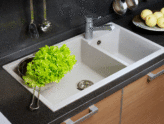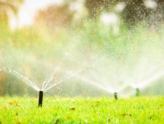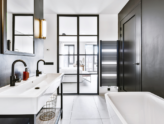Tiny House Plumbing: Efficient Water Systems for Small Spaces
The tiny house movement is a great way to ‘live with less’, taking more ownership for what you consume and how your home lifestyle affects the planet. With a smaller house, your heating, electricity, and water requirements become smaller for more sustainable living.
You can use more sustainable plumbing in a tiny house to create an eco-friendlier water system. But you will need special water systems for small spaces.
What are the best tips and tricks for tiny house plumbing, and what should you consider? Keep reading to learn about finding a water source, sinks, showers, and more! At Caldwell Plumbing, we have experience working with all plumbing systems – including tiny homes. Call us today for plumbing expertise in the Durham Region.
What Are Tiny Homes and Why Are They So Popular?
You can think of a tiny home as a hybrid of a small brick house and a caravan. Tiny homes are portable but can be dismounted from wheels and set in place as needed.
Tiny homes are designed to provide everything you need for permanent residence without a mortgage. Of course, you’ll need to be minimalistic about your belongings, but this is all part of the sustainable lifestyle. Choosing what you purchase and own more carefully leads to less waste and less garbage in landfills.
With house prices rising and climate change in full swing, it’s easy to see why many people are switching to this lifestyle. But how can you achieve a fully functional tiny home, and what’s involved in setting up your plumbing?
How Does A Tiny Home Plumbing System Work?
In a tiny home plumbing system, the water supply enters and forks. One line then supplies water to the water heater, and the other links to the sinks, shower, and washing machine to provide cold water. The water heater has an outgoing link, providing hot water to your bathroom, kitchen, and washing machine.
This water is then collected into the main drain line, filling a used tank with grey and black water. Once full, this water tank is disposed of at a dump station.
People in tiny homes generally have rainwater collection stations with a pump to circulate and pressurize the water for a fully off-grid lifestyle.
Top Tiny Home Plumbing Systems
Here are some tips and ideas for creating a tiny home plumbing system to create space in your home.
Tankless Hot Water Heaters
A tankless hot water heater is the most space-saving solution for a tiny home. Regular water heaters have tanks where water is heated and ready to be transported throughout the property for bathing, cooking, and more.
However, with a tankless hot water heater, there’s no need to assign so much space to your plumbing system. Instead of heating the water in an enclosed container, the boiler heats it by passing it over a hot coil. You can access unlimited hot water, as the water heater doesn’t need to store hot water – so it can’t run out.
Greywater Recycling System
If you want to recycle your water, you can invest in a greywater recycling system rather than dispose of it at a local dump site. Greywater is the water waste from your plumbing system that isn’t contaminated with fecal matter. Water from your toilet that will be contaminated is called blackwater. Blackwater can’t be recycled.
The recycling system takes your greywater and purifies it, removing any waste or contamination so that you can reuse the water around your home. By using this system, you can reduce the amount of water you use over time.
Rainwater Recycling System
Like a greywater recycling system, rainwater recycling allows for water savings only by sourcing water from rainfall rather than wastewater.
The system harvests rainwater from your roof, cleaning and filtering it. You can store this water in a large tank of up to 10,000L for use in your tiny home, reducing reliance on external water sources.
If you’re seeking an off-grid lifestyle, a rainwater harvesting system is certainly a great place to start.
Tiny Bathtub
Just because you’re living in a tiny house doesn’t mean you can’t have a bath. There are plenty of small bathtubs designed to cater to tiny homeowners. One of the most popular solutions is a Japanese-style soaking tub. These tubs are only really suited for petite people, and you won’t be able to lie down during your soak, only sit.
Weight is a serious consideration when installing a bathtub in a tiny property, as water is heavy. Before installing, check that your property can withstand the weight of a bathtub and the water inside it.
Sinks
You’ll likely only have one sink in your tiny home to save space. Choosing the right sink matters, as you’ll use it to wash dishes, wash your hands, perform your skincare routine, and more.
It’s probably best to choose a large sink made from a robust material like porcelain-enameled cast iron, as this will provide the durability required for excessive use.
Shower
When fitting a shower for your tiny home, it’s important to consider space-saving solutions. You might best opt for a wet room, as this will allow you to do away with shower curtains and glass partitions to make your bathroom space more functional. Or, you could choose a traditional wood tub shower, a wooden basin on the floor with a shower overhead. The circular shape makes placement for this shower type more versatile.
Call Caldwell Plumbing For Advice On Tiny House Plumbing
Whether building your tiny home yourself or fitting new bathroom fixtures, there are some significant considerations to make for tiny house plumbing. You have plenty of options, from choosing how to source your water to fitting your home with aptly sized bathroom fittings.
For assistance in setting up a plumbing system for your tiny home or small space, you can rely on expert advice from Caldwell Plumbing. Call us today for installation, repair, and advisory assistance.

















